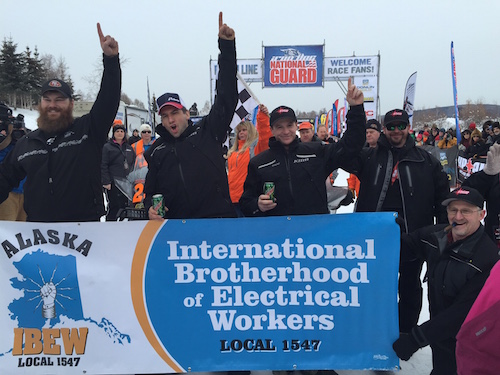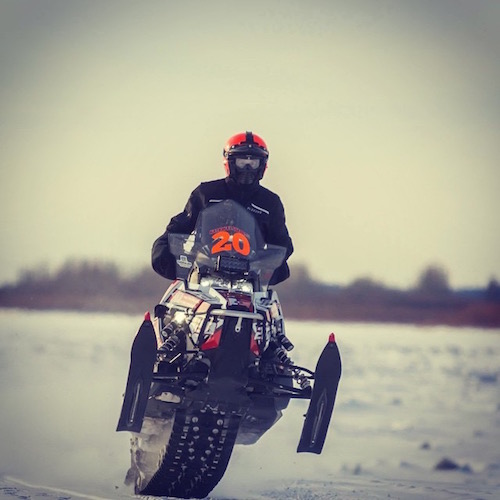Anchorage, Alaska, Local 1547 member Scott Faeo and his teammate Eric Quam won the 2015 running of the longest snowmobile race in the world, the Iron Dog, Feb. 28.
This is Quam’s second win and Faeo’s first, but the journeyman inside wireman for Yukon Electric in Anchorage comes from snow machine racing royalty. His father, John, won a record-tying seven Iron Dogs.
“There are other, smaller races out there. This is Daytona. This is the Superbowl,” Faeo said.
 |
| At the finish line with Anchorage, Alaska, Local 1547 business agent, Waylon Knudsen, Eric Quam, Faeo’s father John, seven-time winner of the Iron Dog. (Photo credit: Waylon Knudsen) |
The first half of the race follows the 1,000-mile Iditarod Trail from Anchorage to Nome made famous by the annual dog sled race. But then the Iron Dog route loops back round another 1,000 miles to Fairbanks in the heart of the Alaskan interior. Over seven days of racing, racers traverse open tundra, two mountain ranges, countless rivers and even race over the sea ice of the Bering Strait. Total distance is the same as a trip from Washington, D.C. to Las Vegas.
Quam and Faeo’s victory was televised live throughout Alaska and they were featured in an NBC Sports channel documentary that aired March 30.
Alaska’s premier snow machine race –they are only called snow mobiles by non-Alaskans -- is run in stages for a week each February. Every racer rides their own snow machine, but for safety, racers pair up in two-person teams. To finish at all, you have to finish together. More than 40 teams competed in the top Pro Class, chasing the glory and $50,000 first prize.
Only snow machines available to consumers off the dealer floor can be ridden in the race and racers usually have (at least) two, one for practice and an identical set-up for the race. Engines must be left bone stock but most racers will spend a lot of time and money upgrading the frame, suspension, lighting and gas tanks to handle the relentless abuse of the Iron Dog. Then there are the spare parts, the support airplane to carry the parts, gas for the 3,000 miles of training rides. Faeo said winning the race will just about give a racer the chance to break even.
The Iron Dog is a test of speed, but it is also a stern test of judgment. Riders normally face race day temperatures that plunge 50 degrees Fahrenheit below zero. At race speed wind chill can push the temperature to near minus 100. But the 2015 race was anything but normal.
“When it is 50 below it [is uncomfortable,] but it was never below zero this year” Faeo said.
Instead of hundreds of miles of powder covered wilderness, the first two days pounded across tawny fields of mud, dirt, rocks and a combination of all three known locally as a ‘tundra head’.
“When there is no snow, it’s like plowing into a field of boulders,” Faeo said about the beach ball-sized clumps of grass and frozen dirt. “It was brutal.”
The Iron Dog
 |
| The 2015 running of the Iron Dog was notable for the unusual lack of snow in the early going of the race. (photo credit: Klim)
|
“I knew it would be brutal, so we paced ourselves and saved our equipment,” Faeo said. “Some guys tried to push it and took a tumble. No mistakes. That was our goal.”
After two days racing north, the teams crossed the first mountain range and approached the Yukon River. Like an ice covered drag strip, this was the fastest part of the race. In year’s past this was a relatively smooth ribbon of ice that stretched out over the horizon --as long as you stay on the trail.
Nearly the entire 2,000 mile trail is marked out by the residents of the many small, often native Alaskan, villages along the way. It might be necessary to leave the trail, but racers know that anything could be hidden just under the snow.
“There are ice chunks and logs. You go off the trail, even 6 inches some places, you are asking for it,” Faeo said. “It is not cool to crash into one of those things at 95 miles an hour and go tumbling down the ice with your snow machine chainsawing after you.”
This terrifying prospect was immaterial this year because of a completely different, possibly more terrifying problem. Warm temperatures meant melting snow and ice. More water meant some rivers that are mirror-smooth sheets of ice most winters were not frozen at all, Faeo said, some running up to 40-feet deep. Other rivers were still frozen, but the ice was overtopped with running water.
This would seem to be an insurmountable barrier for nearly 800 pounds of sled, gas, rider and gear, but a quick search of YouTube proves a modern snow machine well handled is a versatile vehicle.
“You just scoot down one side of the river bed, get up some speed and try to keep [the throttle] as wide-open as possible to get over with enough left to jump out of the ravine,” Faeo said. “You just skip it across.”
To ‘just skip’ a snow machine across open water without bogging down and sinking (which happened to an unfortunate team from Minnesota) requires skill, firm resolve and a head of steam.
“I like to hit water at least going 40 miles per hour, but if it is a really long stretch, like a football field, you need to hit it at 60 or 70,” Faeo said.
Possibly More Terrifying than Skipping a Sled Across a River
 |
| Faeo said the difficult conditions meant as much depended on their skill in the garage before the race as their skill and speed in the saddle. (Photo credit: Waylon Knudsen)
|
Faeo and Quam finished the third day, strongly, but just behind them was the man tied with Faeo’s father John for most Iron Dog wins at seven, Scott Davis, and his teammate Aaron Bartel. Faeo’s father John is retired from racing now, and is now a mechanic, bush pilot and occasional coach on the support team. The win was on the line, but so was the record.
“Having the guy who was my dad’s racing nemesis chasing me down was crazy,” Faeo said. “The whole social media was blowing up about the second generation. That was pressure on pressure.”
And yet there were greater challenges than the river crossings, Faeo said. The worst was farther north, as the race approached the halfway point at Nome, 100 miles south of the Arctic Circle. On the approach to Nome, racers occasionally cross Norton Sound, on the ice covered Bering Sea.
But this year, even the Bering Sea was not frozen solid.
To understand how rare this is, history is helpful. The Iditarod trail itself was created to supply the port city of Nome because Norton Sound froze over every winter. Before regular air service or snow mobiles, when the port was closed, the only way to supply Nome were dog sled caravans.
But the finish line was on the other side of those ice floes.
“The ocean was open,” Faeo said. “Dealing with the waves and the current… it was definitely sketchy. I mean if something happened out there, you are [in a heap of trouble.]”
Winter Is Coming
Faeo and Quam came into the halfway point at Nome Feb. 24 with a 12 minute advantage, meaning they would be the first to leave when racing restarted after a mandatory rest for all racers.
And then winter arrived. The National Weather Service issued a blizzard warning for Nome the next day.
 |
| Average speed for this year’s race was lower than normal—just under 50 mph-- but that doesn’t mean Faeo (pictured) wasn’t hauling the mail when the conditions improved. (Photo credit: Waylon Knudsen)
|
“Blowing snow with poor visibility will continue,” it read. “Travel and outdoor activities will be difficult.”
There are often advantages to leaving first, Faeo said, but he and Quam thought the 50 mph head winds and breaking trail through two foot wind drifts would evaporate their lead. Faeo and Quam disappeared into the blackness of a midwinter morning fearing the race would slip away.
“We ended up clipping along pretty good,” Faeo said. By the first checkpoint 100 miles later they had extended their lead by nearly 20 minutes.
“We could see a little better because the sun had not risen,” Faeo said. “When it did rise, it was very bright and the light was super flat. We could actually see better than the people behind us because of the headlights made it easier to see through the snow.”
By the end of the day, they added another half-hour and despite going off the trail for 10 miles and having to backtrack the next day, the lead held.
The final day of the race, Feb. 26, was timed so all the racers arrived in Fairbanks within a few hours of each other. Only 20 of those 37 pro teams that left Anchorage crossed the finish line. The first dropped out only a few hours from the starting line.
The victory has brought a great deal of attention to Faeo and Local 1547. Support from the snow machine and motorcycle manufacturer Polaris is set to increase. He signed a deal with Mountain Dew and producers from a reality TV show expressed interest in doing a show about the far north racing dynasty.
“It has been really weird,” Faeo said. “It was cool bringing the giant trophy to my old high school, but it is kind of awkward being a small town celebrity.”
Good Racer, Good Electrician
“What makes Scott a good racer is the same thing that makes him a good electrician. He is fast, smooth and efficient,” said Waylon Knudsen, business representative for Local 1547. “It is a logistical nightmare just to get out to some jobs, so once they get there, our members have to be able to do more than bend pipe and pull wire for the union to compete. He can race, but he can lay out the tools and strip down a snow machine and rebuild it in half an hour.”
Knudsen said having a member of Local 1547 has meant a great deal to the 5,000 members of Local 1547.
“There is a huge sense of pride, having a tradesman and one of our win,” Knudsen said. “Our members supported him, sponsored him, paid his entry fee and we are even raffling off the winning sled to support the local’s political action committee.”
But Knudsen said Faeo’s victory is also a story the Local will be using as an organizing tool.
“Here’s a working man with the time and resources to train for and then win a very difficult and expensive race. He had the support of his employer
There is another Local 1547 connection not to be under estimated. Scott’s brother, John, was his chief technical support, and the one who badgered his then-nonunion brother to join up.
“He was hassling me to join,” Faeo said. “He told me to quit [messing] around with no insurance, making Davis-Bacon wages but not doing anything with it. I had to go from being a journeyman to near zero, but it was worth it.”
Faeo is already planning. He helped his brother build a machine for an ice race the following weekend (another victory) and he has his eye on some races outside of Alaska, in Michigan and Minnesota. He is preparing for long hours at work this summer to make time for the training, travel and racing he expects from a busy winter.
“[The owner of Yukon Electric] is big snow machine enthusiast so he’s into it,” Faeo said. “I want to bring some of our Alaska talent down to the Lower 48.”
http://irondog.tv/watch-ktuu-coverage-of-the-live-finish-interviews-analysis/